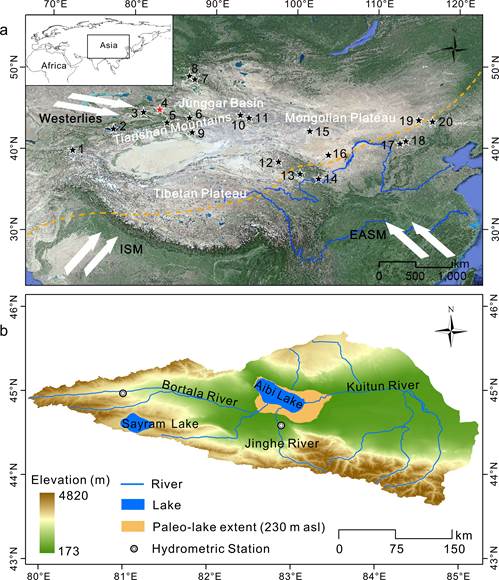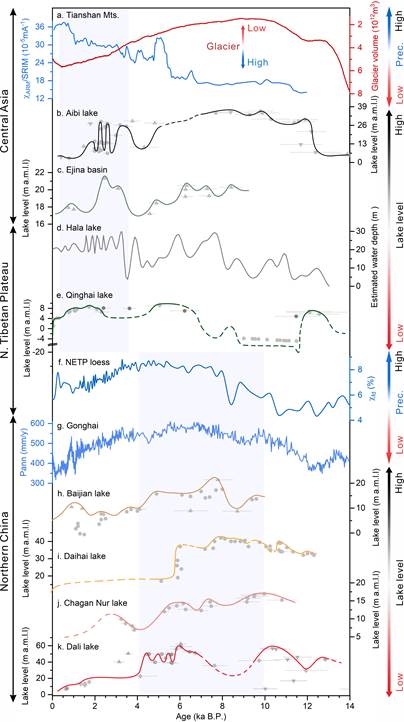Recently, a research team led by Professor Li Guoqiang of the College of Earth and Environmental Sciences at Lanzhou University published their findings on the asynchronous changes in lake levels in the arid regions of mid-latitude Asia, driven by glacial meltwater and the interplay between Westerlies and the East Asian summer monsoon. The study, titled "Asynchronous Holocene lake evolution in arid mid-latitude Asia is driven by glacial meltwater and variations in Westerlies and the East Asian summer monsoon," has been published in the prestigious "Geological Society of America Bulletin," a top-tier geosciences journal.
Asia's inland arid regions represent the world's largest non-zonal arid area, where water is a particularly precious resource. Lakes in these arid zones are vital components of regional water resources and crucial for sustaining the fragile mountain-oasis-desert ecosystems. The lake level changes in these areas are influenced by various factors, including monsoonal and westerly climate systems, glacial meltwater, and human water use, making their evolutionary mechanisms highly complex. This complexity has led to significant debate over how climate change affects hydrological changes in these lakes, posing a critical frontier scientific question that demands resolution.
The researchers conducted systematic geomorphological surveys, accurate elevation measurements, and field sampling at 20 ancient lake embankments around Lake Aibi, one of the typical lakes in Central Asia's arid region (Figure 1). In the laboratory, they used single-grain potassium feldspar luminescence dating to resolve the dating issues caused by complex depositional histories, such as insufficient signal resetting in river and lakeshore sediments, reconstructing accurate lake level changes over the past 18,000 years. The results showed that Lake Aibi, now less than 1.5 meters deep, maintained a low water level of less than 3 meters from 18,000 to 12,000 years ago, then significantly rose to a high level 36 meters above the current lake surface between 10,000 and 8,000 years ago. The lake levels continued to decline to a low of 10 meters from 7,000 to 4,000 years ago, followed by fluctuating increases between 10 and 30 meters from 4,000 to 1,000 years ago. Lake Aibi's water levels demonstrated asynchronous changes with westerly precipitation patterns. The high lake levels during the early Holocene from 10,000 to 8,000 years ago were mainly driven by increased glacial meltwater from the Tianshan mountains due to increased summer solar radiation.
Furthermore, by integrating hydrological models of the watershed, the researchers analyzed the spatial differences and mechanisms behind the lake level changes in the arid region (Figure 2). They discovered that lake levels in the western part of the arid region are influenced by both westerly precipitation and glacial meltwater, while those in the eastern part are primarily controlled by changes in monsoonal rainfall. The asynchronous changes between Westerlies and monsoon precipitation, tuned by glacial meltwater, are the fundamental reasons for the millennial-scale asynchronous lake level changes in the eastern and western parts of the arid region.
This study highlights the pivotal role of glacial meltwater tuning in lake level changes in inland arid regions under natural climate change scenarios. With slight increases in westerly precipitation and global warming leading to increased glacial meltwater, lake levels in Central Asia's arid regions are expected to continue rising, while those in East Asia may decline due to weakening monsoons. Notably, despite recent increases in westerly precipitation and glacial meltwater, many lakes in Central Asia are shrinking due to excessive water resource exploitation, and some face the risk of drying up, further emphasizing the importance of enhanced water management for industrial and agricultural uses in maintaining regional lake levels and the fragile arid-oasis ecosystems.
Professor Li Guoqiang is the first author and corresponding author of the research paper, with Lanzhou University as the primary contributing institution. Wang Yixuan, a senior engineer at the Chinese Academy of Sciences' Qinghai Salt Lake Research Institute, is a co-corresponding author, alongside Dr. Jin Ming, graduate students Wang Xiaoyan and Qin Caixin from Lanzhou University, Dr. Yang He from Chengdu University of Information Technology, and several other domestic and international scholars including professors Zhao Weiwei and Chen Chunzhu from Nantong University, Dr. Tara N. Jonell from the University of Glasgow, Associate Professor Zhang Xiaojian from Nanjing University, and Professor David Madsen from the University of Nevada, Reno, among others.
This research was funded by the National Natural Science Foundation of China (Grant No. 42071101), the Lanzhou University Outstanding Young Scholars Support Plan (Project No. lzujbky-2021-ey22), the Second Qinghai-Tibet Plateau Scientific Expedition and Research Program (Project No. 2019QZKK0602), and the Gansu Provincial Outstanding Youth Fund (Project No. 23JRRA1016).
link to the article:https://pubs.geoscienceworld.org/gsa/gsabulletin/article-abstract/doi/10.1130/B37288.1/638153/Asynchronous-Holocene-lake-evolution-in-arid-mid?redirectedFrom=fulltext

Figure 1.Distribution map of the arid region in inland Asia and the locations of climate-hydrological change records integrated in this study: (a) The location of Lake Aibi marked with a red pentagram; (b) Topographic map of Lake Aibi, with the brown area showing the lake's maximum extent during the high water level period from 10,000 to 8,000 years ago.

Figure 2.Chart of arid region lake level changes and their relationship with Westerlies and monsoon precipitation: (a) Loess records of Westerlies precipitation changes (Li et al., 2015; Chen et al., 2016) and simulated changes in Tianshan glacier volume (Yan et al., 2020); (b) Lake Aibi water level changes reconstructed in this study; (c) Ejin Banner water level changes (Li et al., 2018); (d) Hala Lake water level changes (Yan and Wünnemann, 2014); (e) Qinghai Lake water level changes (Liu et al., 2018); (f) Loess records of East Asian summer monsoon rainfall changes (Li et al., 2020); (g) Gonghai pollen records of East Asian summer monsoon rainfall changes; (h) Baijiantan Lake water level changes (Li et al., 2018; Long et al., 2012); (i) Daihai Lake water level changes (Goldsmith et al., 2022); (j) Chagan Nur water level changes (Li et al., 2020); (k) Dali Lake water level changes (Goldsmith et al., 2022; Jiang et al., 2020; Zhang et al., 2023).